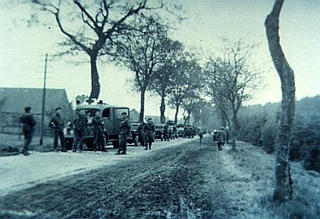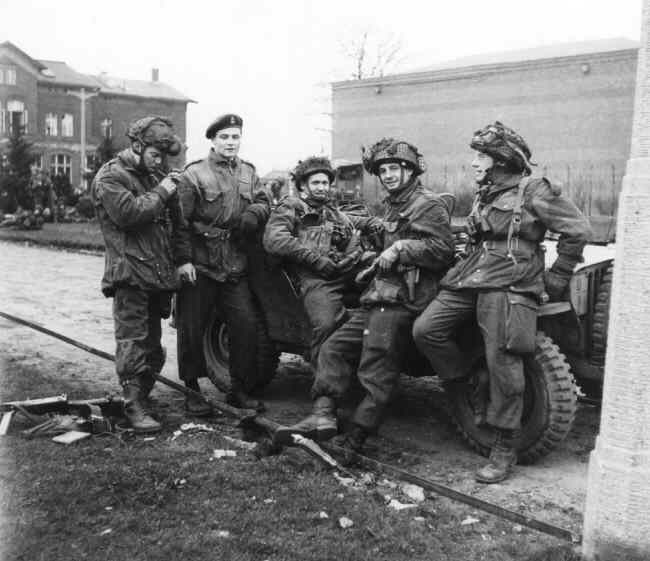NEWSCLIPPINGS
News-clippings from the papers of Pte. Cliff N. Douglas, C Coy 1 Cdn Para Bn. The Brigadier referred to would likely be the much respected Brigadier James Hill who commanded the 3rd Parachute Brigade of which 1 Cdn Para Bn was a part. Remember that these stories were written during the war and no punches were pulled. This web-site Editor has chosen to blank out the name of one soldier in case he prefers anonymity. Web-site editor’s comments are in square brackets [ ].
Paratroops Fight As If Inspired
By Ross Munro [Date about 1944 June 17]
[Website editor’s comments in square brackets.]
WITH THE CANADIAN PARACHUTISTS IN FRANCE –(CP) — For 11 wild days and nights the Canadian parachute unit in the British Sixth Airborne Division fought German infantry and snipers on this incredible battleground east of the River Orne and north-east of Caen.
It was savage, chaotic fighting in closely wooded country, which the Canadians call “squirt-gun territory”. After dropping by parachute before dawn on D-Day, this unit took up positions right on the outside of the perimeter of the beach-head gained by the airborne division east of the river, and there the Canadians stood and battled the enemy. They didn’t yield a yard for 11 days holding vital crossroads and the little hamlet of Le Mesnil on the main Cherbourg-Caen highway.
They fought like men inspired, and their stand at Le Mesnil ranks with the most courageous acts performed in the early phase of the Normandy invasion.
This is the story of this gallant band. The youthful Saskatoon lieutenant-colonel {Lieutenant Colonel G.F.P. Bradbrooke] commanding the unit said the unit went to its airdrome in England the evening of June 5 and got into Douglas [C-47 “Dakota”] transports before midnight and took off for France. As they crossed the Normandy coast at the mouth of the River Orne heavy flak concentrations burst around the planes.
The colonel and the men in his plane jumped, and from scores of other aircraft, airborne troopers leaped into the night and floated to the ground. They came down all over the place — in the woods, on the roads, in the towns, and in muddy bogs dotted with ponds.
The companies were scattered and it took hours for the groups to collect and order to be brought out of this inevitable confusion in the darkness. The colonel himself came down in a bog and plunged into 3-1/2 feet of water. Then he met his intelligence officer [ Lieutenant R.D.J. Weathersbee] and they hustled off to a rendezvous point near Varaville. From there they went four miles down the highway in a south-east direction toward Le Mesnil.
This point they had been told to hold at all costs, and there they dug in and got strong positions in a brick factory. The company [C Coy ] which dropped before the main party [as a protective party for the pathfinders] was scattered in bogs around Varaville. Eventually 40 or 50 of them linked up and attacked a German garrison in the town. There was a fight in the streets and the houses right in the centre of the town where the Germans’ headquarters were located, and the place was captured.
A bridge was blown up by engineers, and the parachutists went down to Le Mesnil for a stand there.
Another company [ B Coy ] landed near Robehomme, four miles east of Le Mesnil, but it was scattered about too. Small batches collected, however, and they too, carried out the company’s task of destroying an important bridge, holding an important position on a hill for days way out in this No-Man’s-Land before withdrawing as planned.
Another company [ A Coy ] was to protect the flank of a British parachute battalion [ 9 Para Bn] in an attack on a coastal battery at Merville, just east of the mouth of the Orne River. The company did get together and supported 130 British paratroopers as they stormed and cleaned out the Merville position. These Canadians too eventually linked up with the main force at Le Mesnil.
In Le Mesnil the Canadians were sniped at from buildings when they established themselves, and the colonel posted an anti-tank gun on the cross-roads. It had only a dozen rounds of ammunition, but with eight shells the snipers were driven from the buildings.
During the first day more men from the scattered Canadian unit drifted into Le Mesnil, and for three or four days after they kept coming. By the evening of D-Day, there were 200 parachutists in Le Mesnil ready for the enemy.
The Germans came at them the next day and were beaten off by machine-guns and rifles. On the second day the Canadians received artillery support. The Germans put in a bang up attack on this second day, and the colonel said: “It was a dilly.” The Canadians hurled it back too, killing dozens of Germans in the woods and on the roads.

MOTORCYCLISTS CAPTURED WITH CANES
Canuck Paratroop’s Speed
Upsets Nazi Defense Plans
WITH CANADIAN PARATROOPS NEAR HANNOVER, Germany, April 12 [1945] – (CP)
The 1st Canadian Parachute Battalion’s drive eastward towards Hannover and Berlin has been a succession of experiences of finding the German altogether unprepared to receive it.
The speed with which the Canadians, part of the British 6th airborne division, moved and the surprise they achieved, are illustrated in the capture of Greven, 22 miles southwest of Osnabrueck, a week ago.
Paratroopers under Capt. Russ Harrison of Winnipeg, rode on British Grenadier Guards tanks within 1 1/2 miles of the town, then dismounted and proceeded afoot one hour after dark.
Harrison only allowed German-speaking personnel to talk as the Canadian s advanced single file.
Soldiers like Bernard Schweedich of Ladywood, Man., or L-Cpl Alfred Kraucht [KRAUGHTI] of Deloraine, Man., engaged in apparently desultory conversation between themselves or wisecracked with groups of Germans passing by.
The main body made straight for a key bridge in the centre of Greven. An enemy column approached, armed with bazookas and anti-tank guns. They were at point blank range before Harrison opened fire. The shooting was over in less than five minutes.
“It was the finest piece of execution I’ve ever seen,” commented the brigadier the following morning.
Entering into the spirit of Harrison’s plan, the troops had quietly accounted for every German soldier on the way into town. Motorcyclists overtaking the paratroopers were hooked off their motorcycles by canes some of the Canadians carried and “done in.”
L-Cpl J[___] B[______] of Winnipeg, tore a German off a cycle with his bare hands and killed him.
A slight noise brought an officer from one house in Greven and Kraucht [KRAUGHTI] challenged him in
German.
The enemy major flew into a rage at being challenged but when he was taken prisoner by Kraucht [KRAUGHTI] he became helpless with anger. He had returned from the Russian front on compassionate [leave] only two hours [before].

Greven, Germany 1945 April 04. Some officers of 1 Canadian Parachute Battalion.Left to right: Lt. W. A. Jenkins, Capt. P. G. Costigan, Lts. G.A. Menn, G.J. Fisher, A.O. Tucker [Signals Officer].
Photographer C. H. Richer Photo # CHR49322 (National Archives of Canada # PA 115016).